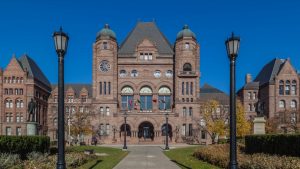Construction stakeholders are hailing the Ontario government’s recent announcement of $500 million to support the operating costs of municipalities as highly welcome support that will ensure spring and summer municipal projects go out to tender as usual.
Minister of Municipal Affairs and Housing Steve Clark announced the funding March 4, noting the province’s 444 municipalities are facing additional operating costs associated with the pandemic and need relief.
“It’s something that we’ve been advocating for for quite some time as we’ve been watching a number of municipalities dipping into their capital funds in order to cover their operational expenses, particularly those municipalities running transit and other expenses that they have to cover as well as operating expenses because of COVID-19,” said Karen Renkema, Ontario vice-president of the Progressive Contractors Association of Canada.
“We need to somehow prop up these operating budgets, so that capital expenditures don’t continue to get cancelled. I think for municipalities as they’re right in the midst of finishing up budgets, it gives them a bit of a backstop to say, OK we can continue with our plans.”
Council of Ontario Construction Associations president Ian Cunningham noted local governments have been financially “decimated” as a result of the pandemic, with reduced revenues in many operating categories including parking, transit, recreation and other programs while their costs have remained relatively fixed.
In addition, said Cunningham, their cash flows have dried up due to delayed payments of property taxes by businesses and workers hurt by the pandemic.
“The $500 million in funding announced yesterday to help cities and towns sustain their operations is much needed, very helpful and couldn’t have come too soon. We look forward to seeing more support for local governments in the upcoming provincial budget, support that will allow cities and towns to move forward with their planned infrastructure programs.”
The spending supplements allocations made last year through the joint federal-provincial Safe Restart Agreement, with $1.39 billion announced in two tranches.
“The OGCA has been pushing for a renewal of the Safe Restart Agreement in 2021 and for an aggressive plan for both short-term and long-term infrastructure investment,” commented Ontario General Contractors Association president Giovanni Cautillo. “General contractors are ready and able to start building for recovery in Ontario.”
The need for a third instalment was raised by Ontario Sewer and Watermain Construction Association executive director Patrick McManus at the association’s recent annual meeting, with McManus noting sewer and watermain contractors were fearful 2021 projects in their sector would not proceed.
“Yes, we are quite pleased,” he said. “We very much appreciate the province leading the way on this.”
A statement issued by the Residential and Civil Construction Alliance of Ontario added, “When the province and the federal government collaborate, all the challenges can be met in a constructive way to keep people working, while ensuring that critical infrastructure work takes place.”
Renkema said the delays in tendering capital projects were more than just hypothetical.
“We were seeing projects that were slated for 2020 budgets, at the end of 2020, that either were not tendered, not procured or delayed. Talking to a number of contractors, the pipeline is very slow. In March you expect to start seeing a number of things, particularly in the civil sector, pop up and the pipeline has been slower than anticipated.”
“Banner” projects are still moving forward, Renkema said, but small to medium-sized projects that are more under the radar were coming off municipal dockets.
“We can’t necessarily make the commercial market come back quicker but we can continue to invest in the institutional, the public market, in order to prop that up until we see some more private investment.”











Recent Comments
comments for this post are closed